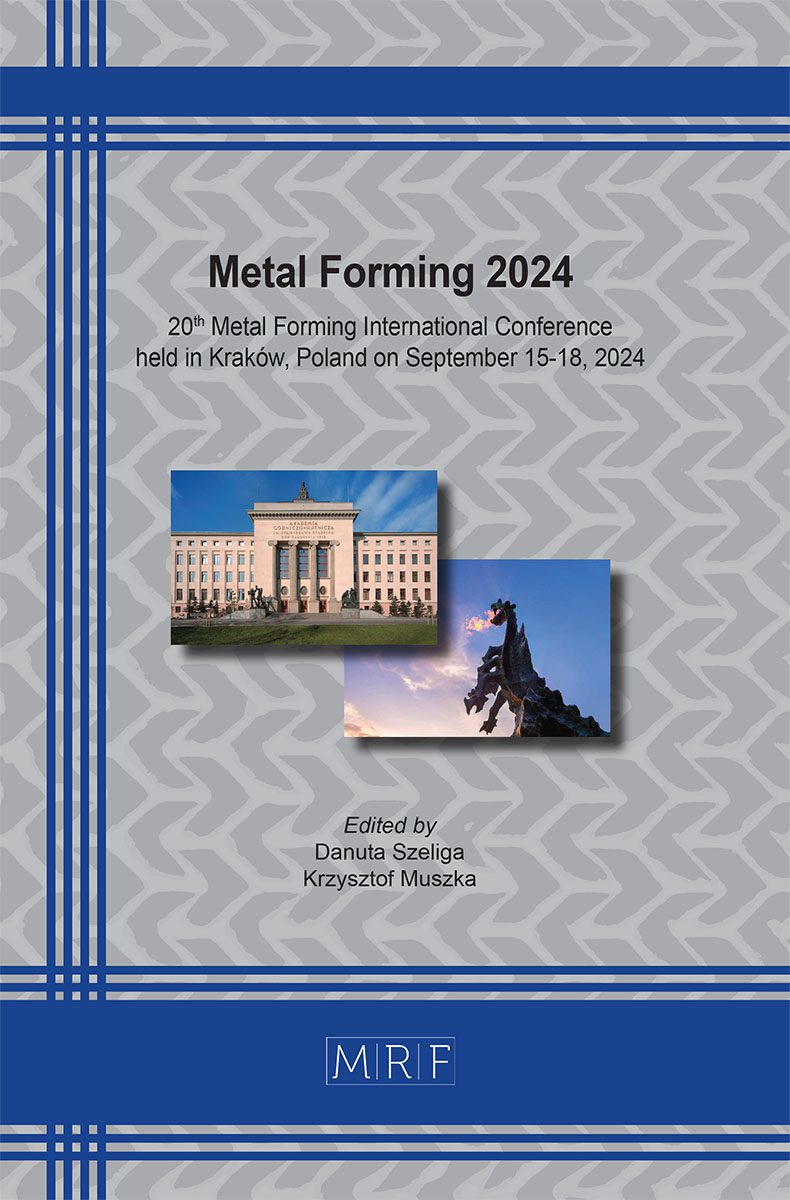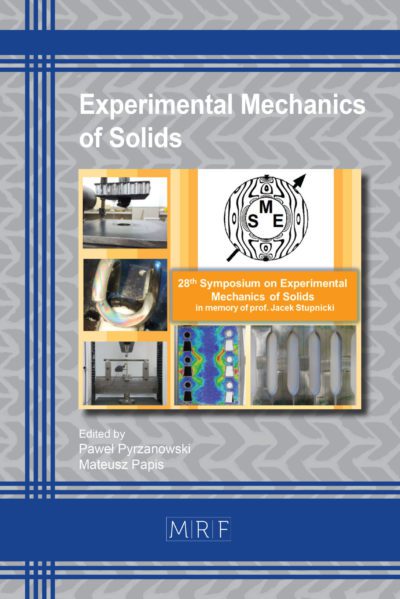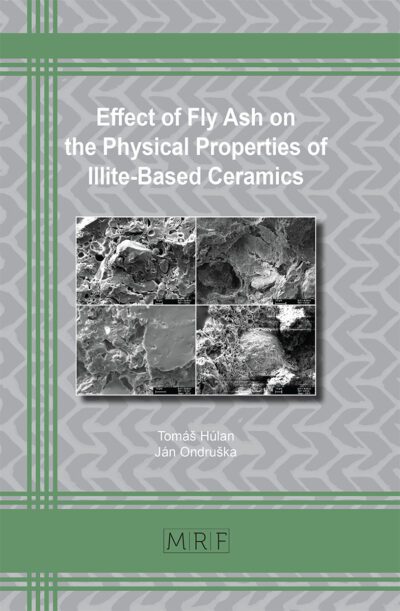–
Modelling of dynamic scale layer growth considering temperature, time and alloying elements
BERGELT Tim, GRAF Marcel, HUNZE-TRETOW Jan, BEHRENS Bernd-Arno, LAMPKE Thomas
download PDFAbstract: During hot forming of steel oxide scaling occurs at higher temperatures caused by reactions with oxide containing atmospheres. Three characteristic iron oxides exist for steel at temperatures above 570°C: Wustite (FeO), magnetite (Fe3O4) and hematite (Fe2O3). Scale layer formation is influenced by various process parameters, such as temperature, process time and furnace atmosphere. Additionally, the base material with different alloying elements (e.g. C, Cr, Si and Ni) also affects the scale layer formation. Therefor oxide scales are very difficult to handle in the entire manufacturing process. The aim of this work is to examine and evaluate the influence of temperature, time and the alloying elements C and Cr in association with the layer growth, layer composition and thermophysical properties for scale layers. Based on the achieved correlations, a model is developed, which is able to predict the scale formation and scale properties, depending on temperature, time and alloying elements. With rising temperature and time increasing layer thicknesses were observed. Further, the additional Cr ensured lower layer thicknesses compared to the unalloyed steels. The iron oxide distribution changed with rising temperature to higher oxide containing phases like magnetite and hematite. The mathematical model, developed based on this results, is able to calculate the resulting layer structure, thickness and thermophysical properties depending on temperature, time and chemical composition of the material.
Keywords
Scale Layer, Microstructure, Thermophysical Properties, Modelling
Published online 9/15/2024, 11 pages
Copyright © 2024 by the author(s)
Published under license by Materials Research Forum LLC., Millersville PA, USA
Citation: BERGELT Tim, GRAF Marcel, HUNZE-TRETOW Jan, BEHRENS Bernd-Arno, LAMPKE Thomas, Modelling of dynamic scale layer growth considering temperature, time and alloying elements, Materials Research Proceedings, Vol. 44, pp 482-492, 2024
DOI: https://doi.org/10.21741/9781644903254-52
The article was published as article 52 of the book Metal Forming 2024
![]() Content from this work may be used under the terms of the Creative Commons Attribution 3.0 license. Any further distribution of this work must maintain attribution to the author(s) and the title of the work, journal citation and DOI.
Content from this work may be used under the terms of the Creative Commons Attribution 3.0 license. Any further distribution of this work must maintain attribution to the author(s) and the title of the work, journal citation and DOI.
References
[1] R.M. Pineda Huitron, P.E. Ramírez López, E. Vuorinen, P. Nazen Jalali, L. Pelcastre, M. Kärkkäinen, Scale Formation on HSLA Steel during Continuous Casting Part I: The Effect of Temperature–Time on Oxidation Kinetics, Metals 10 (2020) 1243. https://doi.org/10.3390/met10091243
[2] E. Wielgosz, T. Kargul, J. Falkus, Comparison of experimental and numerically calculated thermal properties of steels, METAL 2014 – 23rd International Conference on Metallurgy and Materials, Conference Proceedings (2014).
[3] M. Graf, M. Ullmann, G. Korpala, H. Wester, B. Awiszus, R. Kawalla, B.-A. Behrens, Forming and Oxidation Behavior During Forging with Consideration of Carbon Content of Steel, Metals 8 (2018) 996. https://doi.org/10.3390/met8120996
[4] D.J. Young, J. Zurek, L. Singheiser, W.J. Quadakkers, Temperature dependence of oxide scale formation on high-Cr ferritic steels in Ar–H2–H2O, Corrosion Science 53 (2011) 2131–2141. https://doi.org/10.1016/j.corsci.2011.02.031
[5] F.H. Stott, G.C. Wood, J. Stringer, The influence of alloying elements on the development and maintenance of protective scales, Oxid Met 44 (1995) 113–145. https://doi.org/10.1007/BF01046725
[6] S.K. Dubey, P. Srinivasan, Development of three dimensional transient numerical heat conduction model with growth of oxide scale for steel billet reheat simulation, International J. Therm. Sci. 84 (2014) 214–227. https://doi.org/10.1016/j.ijthermalsci.2014.05.022
[7] M. Krzyzanowski, J.H. Beynon, Modelling the Behaviour of Oxide Scale in Hot Rolling, ISIJ Int. 46 (2006) 1533–1547. https://doi.org/10.2355/isijinternational.46.1533
[8] M. Takeda, T. Onishi, S. Nakakubo, S. Fujimoto, Physical Properties of Iron-Oxide Scales on Si-Containing Steels at High Temperature, Mater. Trans. 50 (2009) 2242–2246. https://doi.org/10.2320/matertrans.M2009097
[9] T. Akiyama, H. Ohta, R. Takahashi, Y. Waseda, J. Yagi, Measurement and Modeling of Thermal Conductivity for Dense Iron Oxide and Porous Iron Ore Aggliomerates in Stepwise Reduction, ISIJ Int. 32 (1992) 829–837. https://doi.org/10.2355/ISIJINTERNATIONAL.32.829
[10] J. Slowik, G. Borchardt, C. Köhler, R. Jeschar, R. Scholz, Influence of oxide scales on heat transfer in secondary cooling zones in the continuous casting process, part 2: determination of material properties of oxide scales on steel under spray‐water cooling conditions, Steel Res. 61 (1990) 302–311. https://doi.org/10.1002/srin.199000353
[11] J. Mo/lgaard, W.W. Smeltzer, Thermal Conductivity of Magnetite and Hematite, J. Appl. Phys. 42 (1971) 3644–3647. https://doi.org/10.1063/1.1660785
[12] Y. Grosu, A. Faik, I. Ortega-Fernández, B. D’Aguanno, Natural Magnetite for thermal energy storage: Excellent thermophysical properties, reversible latent heat transition and controlled thermal conductivity, Solar Energy Materials and Solar Cells 161 (2017) 170–176. https://doi.org/10.1016/j.solmat.2016.12.006
[13] E. Beygelzimer, Y. Beygelzimer, Thermal conductivity of oxide scale and its components in the range from 0 C to 1300 C: Generalized estimates with account for movability of phase transitions, 2021.
[14] R.Y. Chen, W.Y.D. Yuen, A Study of the Scale Structure of Hot-Rolled Steel Strip by Simulated Coiling and Cooling, Oxid. Met. 53 (2000) 539–560. https://doi.org/10.1023/A:1004637127231
[15] G. Korpała, M. Ullmann, M. Graf, H. Wester, A. Bouguecha, B. Awiszus, B.-A. Behrens, R. Kawalla, Modelling the influence of carbon content on material behavior during forging, Penang, Malaysia, Author(s), 2017, p. 190013
[16] E. Beygelzimer, Y. Beygelzimer, Generalized estimates for thermal expansion of oxide scale in the range from 0C to 1300C with account for movability of phase transitions in its components, 2021.
[17] E. Beygelzimer, Y. Beygelzimer, Heat Capacity of oxide scale in the range from 0 C to 1300 C: Generalized estimates with account for movability of phase transitions, 2021.
[18] F. Grønvold, A. Sveen, Heat capacity and thermodynamic properties of synthetic magnetite (Fe3O4) from 300 to 1050 K. Ferrimagnetic transition and zero-point entropy, J. Chemic. Thermodynamic. 6 (1974) 859–872. https://doi.org/10.1016/0021-9614(74)90230-4
[19] J.P. Coughlin, E.G. King, K.R. Bonnickson, High-temperature Heat Contents of Ferrous Oxide, Magnetite and Ferric Oxide 1, J. Am. Chem. Soc. 73 (1951) 3891–3893. https://doi.org/10.1021/ja01152a098














